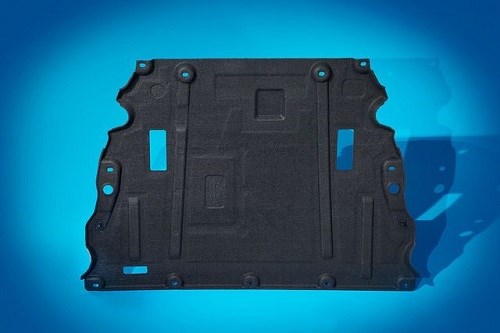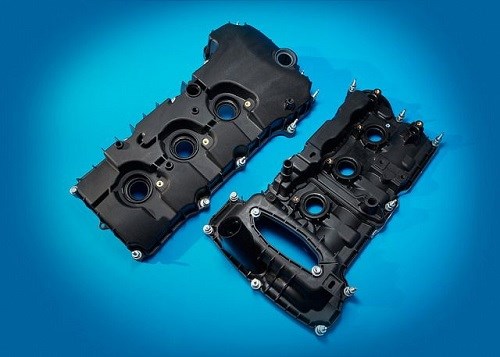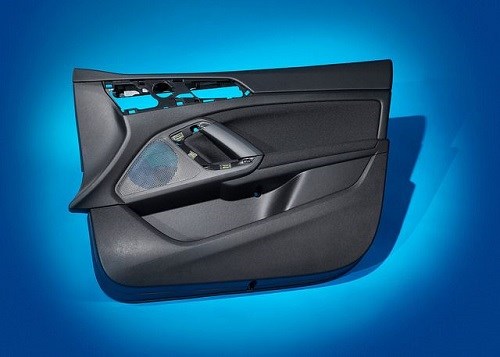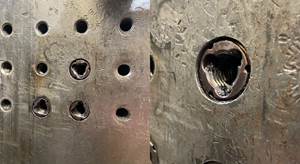Environmental & Safety Finalists of SPE Auto Innovation Awards
The three finalists in the environmental and two in the safety categories utilize recycled resin, natural fiber reinforcements and more.
The three finalists in the environmental and two in the safety categories utilize recycled resin, natural fiber reinforcements and more.
This in one of two of my last blogs on the 2015 SPE Automotive Innovation Awards with a focus on three finalists of the environmental and two of the safety categories, respectively, that deserve mention.
• Underbody Aero Shields: In this application, featured on the 2016 Ford Fusion, underbody shields using virgin glass-reinforced PP were replaced by a material made of PET, half of which was sourced from recycled water bottles. The result: lower cabin noise/better acoustics, better thermal performance, a 2% cost savings, and a more environmentally responsible option. US Farathane Corp. supplied both the system and the material.

• PCR Cam Cover: This is featured on Ford’s 2015 Nano 2.7L and 3.5L IVCT GTDI engines. It is the first time in a demanding cam cover application where a 100% post-consumer recycled nylon 66 resin with 33% short-glass reinforcement was used to replace die-cast aluminum.

The system is injection molded by ErlingKlinger North America from Ecolon GF1960 PCR nylon 66 from Wellman Advanced Materials. The material offers excellent weldability to attach a high-efficiency air-oil separator and was molded in very thin walls to 2.0 mm (0.079 in.) for the Nano-model cover. The result: a part that is 30% lighter than incumbent aluminum, offers lower NVH values plus a 20% material cost reduction versus virgin resin, while also diverting carpet from landfills.
• Natural Fiber-Reinforced PP: Featured in the 2013 PSA Peugeot Citroen interior doors is a 20% hemp-filled PP that reduces part weight by up to 25% compared to the higher density glass-reinforced PP previously used. Moreover, it allows wall stock to be lowered to 2 mm (0.079 in.).

The part is molded by Faurecia Interior Systems with the Nafilean PF2 PP/NF20 materials from Automotive Performance Materials. The 20% bio content reduces the part’s CO2 emissions by 20% during its use life. The material is fully recyclable and can be processed on conventional molding machines at lower energy consumption.
• Direct Fascia-Mounted Sensor: This is featured on the 2015 Ford Mustang. It is a flexible pedestrian-protection crash sensor bracket injection molded in plastic with an embedded metal stud that is sonically welded directly to the fascia skin to decrease signal noise and improve response time of the deployable hood system.
The system is molded by MacLean-Fogg Co. with Hifax 852X TPO from LyondellBasell. The flexibility of the design helps the bracket to conform to different fascia contours, allowing for a single bracket design to be used in multiple locations on the same vehicle or across different vehicle lines. The final design saved 1 lb and $7/vehicle and allows the hood to deploy faster for greater pedestrian safety.
• Unidirectional Inertial Lockout: Featured on Ford’s 2016 Lincoln MKC, this console bin door has no latch in the closed position, but a unidirectional inertial lockout feature was implemented to meet FMVSS 201. The Tier 1 is International Automotive Components Group, which molds the system from Celanese’s Celcon LW90-S2 silicone-impregnated polyacetal.
The lockout’s inertial sensitivity is defined by part geometry, allowing it to be made of any material while maintaining the same inertial properties. A single injection-molded snap-in lever plus felt tape replaced multiple die-cast metal components, minimizing testing costs due to compliance the first time. It also increased reliability, and resulted in a savings of $0.84 versus the previous metal option.
Search for nearly 100,000 grades of polymers on the Universal Selector by clicking here: http://www.ptonline.com/materials
Related Content
Paperless ‘Smart Factory’ Based on Automated Production Monitoring
Tier 1 automotive molder’s home-built production-monitoring and ERP systems, designed for “the little guy,” boost its efficiency rating and profits.
Read MoreMolder Repairs Platen Holes with Threaded Inserts
Automotive molder ITW Deltar Fasteners found new life for the battered bolt holes on its machine platens with a solution that’s designed to last.
Read MoreAdditive Fusion Technology Optimizes Composite Structures for Demanding Applications
9T Labs continues to enhance the efficiency of its technology, which produces composite parts with intentionally oriented fibers.
Read MoreIndustrial Resin Recycling Diversifies by Looking Beyond Automotive
Recycler equips for new 大象传媒 in medical, housewares and carpeting.
Read MoreRead Next
Beyond Prototypes: 8 Ways the Plastics Industry Is Using 3D Printing
Plastics processors are finding applications for 3D printing around the plant and across the supply chain. Here are 8 examples to look for at NPE2024.
Read MoreMaking the Circular Economy a Reality
Driven by brand owner demands and new worldwide legislation, the entire supply chain is working toward the shift to circularity, with some evidence the circular economy has already begun.
Read MoreSee Recyclers Close the Loop on Trade Show Production Scrap at NPE2024
A collaboration between show organizer PLASTICS, recycler CPR and size reduction experts WEIMA and Conair recovered and recycled all production scrap at NPE2024.
Read More














